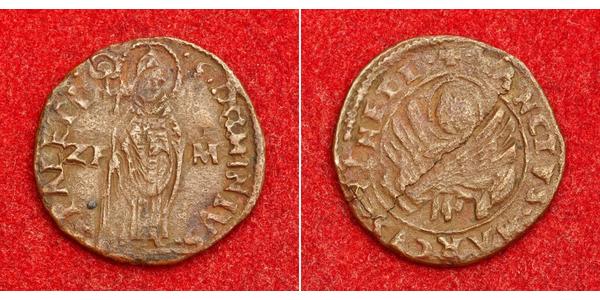(售价 $136.0)
1518, Croatia, Split (Venetian protectorate). Cu "St. Domnius" Bagattino Coin.
Denomination: Bagattino Mint Period. 1491-1518 Mint Place: Split (Spaleto) Mint Master: Zuan Francesco Miani Reference: D&D 4.3.1.1; Paolucci 761. Rare! Condition: Struck on a laminated planchet (see edge pictures), moderate corrosion (environmental damage), otherwise VF! Material: Copper Diameter: 18mm Weight: 1.72gm
Obverse: Saint Domnius (Sveti Djam), wearing episcopal regalia, standing facing, holding crozier. Legend: S . DOMINVS . - . SPALETI Reverse:Nimbate facing half-length Lion of Saint Marc (Sveti Marko), forepaw supporting open Gospel. Legend: + . SANCTVS . MARCVS . VENETI .
Saint Domnius (also known as Saint Dujam or Saint Duje, Saint Domnio, Saint Doimus, or Saint Domninus) was a 3rd-century Bishop of Salona and patron of the city of Split. Salona was a large Roman city serving as capital of the Province of Dalmatia. Today it is located near the city of Split in modern Croatia. Saint Domnius was martyred with seven other Christians in the persecutions of the Emperor Diocletian. He was born in Antioch, in modern-day Turkey but historically in Syria, and beheaded in 304 at Salona. He was more likely a martyr of the 4th century, but Christian tradition also states that he was one of the Seventy Disciples of the 1st century. This tradition holds that Domnio came to Rome with Saint Peter and was then sent by Peter to evangelize Dalmatia, where he was martyred along with 8 soldiers he had converted. His relics were later moved to the Cathedral of Saint Domnius. When Salona was sacked by the Avars and Slavs in the 6th century, the population eventually moved to the nearby Palace of Diocletian, enlarging the nearby city of Split (Spalatum), and establishing it as the successor to Salona. Saint Domnius became the city's patron saint, and the city's cathedral (the Cathedral of Saint Domnius) was built in the mausoleum of Diocletian itself, the emperor who martyred him. The Basilica of St. John Lateran in Rome claims to own some of Domnio's relics, since Pope John IV, in the 7th century, had requested that relics of a martyr named Domnio be brought to Rome.
em>.
Split is the second-largest city of Croatia and the largest city of the region of Dalmatia. It lies on the eastern shore of the Adriatic Sea and is spread over a central peninsula and its surroundings. An intraregional transport hub and popular tourist destination, the city is linked to the Adriatic islands and the Apennine peninsula.
Home to Diocletian's Palace, built for the Roman emperor in 305 CE, the city was founded as the Greek colony of Aspálathos (Aσπάλαθος) in the 3rd or 2nd century BC. It became a prominent settlement around 650 CE when it succeeded the ancient capital of the Roman province of Dalmatia, Salona. After the Sack of Salona by the Avars and Slavs, the fortified Palace of Diocletian was settled by the Roman refugees. Split became a Byzantine city, to later gradually drift into the sphere of the Republic of Venice and the Kingdom of Croatia, with the Byzantines retaining nominal suzerainty. For much of the High and Late Middle Ages, Split enjoyed autonomy as a free city, caught in the middle of a struggle between Venice and the King of Hungary for control over the Dalmatian cities.
Venice eventually prevailed and during the early modern period Split remained a Venetian city, a heavily fortified outpost surrounded by Ottoman territory. Its hinterland was won from the Ottomans in the Morean War of 1699, and in 1797, as Venice fell to Napoleon, the Treaty of Campo Formio rendered the city to the Habsburg Monarchy. In 1805, the Peace of Pressburg added it to the Napoleonic Kingdom of Italy and in 1806 it was included in the French Empire, becoming part of the Illyrian Provinces in 1809. After being occupied in 1813, it was eventually granted to the Austrian Empire following the Congress of Vienna, where the city remained a part of the Austrian Kingdom of Dalmatia until the fall of Austria-Hungary in 1918 and the formation of Yugoslavia. In World War II, the city was annexed by Italy, then liberated by the Partisans after the Italian capitulationin 1943. It was then re-occupied by Germany, which granted it to its puppet Independent State of Croatia. The city was liberated again by the Partisans in 1944, and was included in the post-war Socialist Yugoslavia, as part of its republic of Croatia. In 1991, Croatia seceded from Yugoslavia amid the Croatian War of Independence.
4 Groschen 普魯士王國 (1701 - 1918) 銀 腓特烈·威廉三世 (1770 -1840)
本组有 6 钱币 / 5 售价
⇑







-300-150-sSshwJfl8_cAAAGL1F9TnYK4.jpg)







